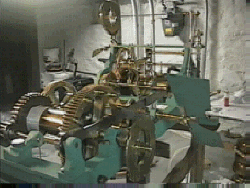RESTORATION OF A NINETEENTH CENTURY FRENCH TOWER CLOCK |
|||||||||||||||||||||||
Welcome to my web page whose purpose is to share my enthusiasm for the restoration and preservation of tower clocks. The Wagner clock, illustrated below, is described in most detail, followed by a page showing my tower clock collection and then subsequent pages briefly depicting my other tower clock restorations. If you are interested in sharing your knowledge of these marvelous clocks, please contact me. If you know of a movement in need of rescue - I may be interested in it's purchase and it will subsequently appear in this page. Let's talk! mailto:mfrank1@rcn.com |
|||||||||||||||||||||||
 |
DESCRIPTION OF THE CLOCK The clock pictured here is a two train French tower clock c.1870 by Collin-Wagner, the successor company to Jean Wagner a principal based in Paris (see name plate picture). Mr. Wagner was a maker of some repute and is described in G.H. Baillie, Watch & Clockmakers of the World, Vol. 1, page 331. His several achievements in the design of tower clocks described therein are represented in this clock. The basic frame is made of cast iron in a 'flatbed' design. This design became popular around the mid nineteenth century and was the last in a series of varying frame designs used for tower clocks beginning in the twelfth century. The flatbed was used as a base. Wheel bearings, were then bolted onto this bed. In addition the two upright "A" frames containing the going train (time side) are bolted to the flatbed. This layout would ideally allow the removal of any one wheel without disturbing another but generally this is not completely achieved. In this movement the strike train wheels are independently removable, but some in the going train are not. Removable bushings, also a.k.a. Vulliamy bushings, can also achieve the same end and these are used to some degree in the going train. Overall dimensions are 34w" x 14d" x 24h", weight is approximately 200 lbs. The wood stand is original. One of the most interesting features of this clock is the remontoire. This is a mechanism that provides a constant, even source of power to the escape wheel. It also isolates the escapement from the vagaries of weather on the clock face hands as well as other frictional and engineering inaccuracies that would otherwise be transmitted through the wheel train back to the escapement. The action of the fly fan and the recoil of the remontoire cage makes for a fascinating view. It's repair diagram and the mechanism is shown under the 'Repair Sessions' section. The pilot face is beautifully skeletonized and driven through a series of linkages; bevel gears. The compensated pendulum of one second cycle has a large, fine adjusting nut at the top; the escapement is a pinwheel. It has a Harrison's maintaining power system. Striking is controlled by a count wheel and rings the hours and half hour. There are two hammer arms, each actuated one just after the other; making this a "bim bam" striker. Restoration was completed in 1998. Over the years I have found that when I divide the time it takes to do a movement by the number of parts it comes out to an average of 30 minutes per piece. Click here for pictures of restored movement. |
||||||||||||||||||||||
 |
|||||||||||||||||||||||
 |
|||||||||||||||||||||||
 |
|||||||||||||||||||||||
|
|||||||||||||||||||||||
| I am always interested in the purchase of tower clocks for my continued restoration enjoyment. I do not profit from this. Let me know your feedback, suggestions or your experience with tower clocks. Email me! mailto:mfrank1@rcn.com | |||||||||||||||||||||||